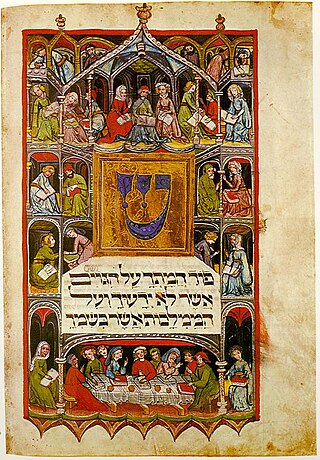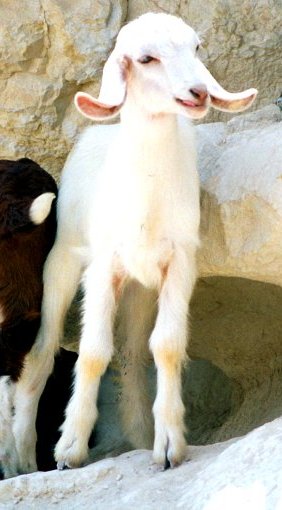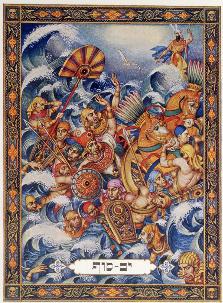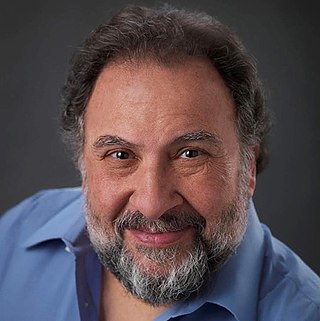Related Research Articles

A siddur is a Jewish prayer book containing a set order of daily prayers. The word siddur comes from the Hebrew root ס־ד־ר, meaning 'order.'
Kitniyot is a Hebrew word meaning legumes. During the Passover holiday, however, the word kitniyot takes on a broader meaning to include grains and seeds such as rice, corn, sunflower seeds, and sesame seeds, in addition to legumes such as beans, peas, and lentils.

The tradition of humor in Judaism dates back to the Torah and the Midrash from the ancient Middle East, but generally refers to the more recent stream of verbal and often anecdotal humor of Ashkenazi Jews which took root in the United States over the last hundred years, including in secular Jewish culture. European Jewish humor in its early form developed in the Jewish community of the Holy Roman Empire, with theological satire becoming a traditional way of clandestinely opposing Christianization.

The Haggadah is a Jewish text that sets forth the order of the Passover Seder. According to Jewish practice, reading the Haggadah at the Seder table is a fulfillment of the mitzvah to each Jew to tell their children the story from the Book of Exodus about God bringing the Israelites out of slavery in Egypt, with a strong hand and an outstretched arm.

Shlomo Moshe Amar is the former Sephardic Chief Rabbi of Israel. He served in the position of Rishon LeZion from 2003 to 2013; his Ashkenazi counterpart during his tenure was Yona Metzger. Since 2014, he currently serves as the Sephardic Chief Rabbi of Jerusalem.
David M. Bader is an author and former attorney.
Zen Judaism: For You a Little Enlightenment is a humor book by David M. Bader, the author of Haikus for Jews: For You a Little Wisdom (1999) and Haiku U.: From Aristotle to Zola, Great Books in 17 Syllables.

Benjamin Joseph Manaly Novak is an American actor, director and screenwriter. He has received five Primetime Emmy Award nominations and won two Screen Actors Guild Awards.

The history of Jews in Bosnia and Herzegovina spans from the arrival of the first Bosnian Jews as a result of the Spanish Inquisition to the survival of the Bosnian Jews through the Holocaust and the Yugoslav Wars. Judaism and the Jewish community in Bosnia and Herzegovina has one of the oldest and most diverse histories in the former Yugoslav states, and is more than 500 years old, in terms of permanent settlement. Then a self-governing province of the Ottoman Empire, Bosnia was one of the few territories in Europe that welcomed Jews after their expulsion from Spain.

Chad GadyaorHad Gadya is a playful cumulative song in Aramaic and Hebrew. It is sung at the end of the Passover Seder, the Jewish ritual feast that marks the beginning of the Jewish holiday of Passover. The melody may have its roots in Medieval German folk music. It first appeared in a Haggadah printed in Prague in 1590, which makes it the most recent inclusion in the traditional Passover seder liturgy.

The Szyk Haggadah is a Passover Haggadah that was illustrated by the Polish-Jewish artist Arthur Szyk in Poland between 1934 and 1936. Szyk's visual commentary on the ancient story of Passover uses the vocabulary and format of an illuminated manuscript; each of his 48 full-page watercolor and gouache illuminations contains the traditional text of the Haggadah, which is clarified and interpreted by the images and symbols on the same page.

Kol Menachem is a non-profit independent Chabad publishing house based in Crown Heights, Brooklyn, founded by philanthropist Meyer Gutnick and Rabbi Chaim Miller in 2000. Its goal is "to organize the teachings of Rabbi Menachem Mendel Schneerson and make them universally accessible and useful."

Joel Chasnoff is an American-Israeli stand-up comedian and writer with stage and screen credits in eight countries, and author of the comic memoir The 188th Crybaby Brigade, about his year as a tank soldier in the Israeli Army.

Sir Moses Haim Montefiore, 1st Baronet, was a British financier and banker, activist, philanthropist and Sheriff of London. Born to an Italian Sephardic Jewish family based in London, after he achieved success, he donated large sums of money to promote industry, business, economic development, education and health among the Jewish community in the Levant. He founded Mishkenot Sha'ananim in 1860, the first settlement outside the Old City of Jerusalem.
Marc Michael Epstein is Professor of Religion and Visual Culture on the Mattie M. Paschall (1899) & Norman Davis Chair at Vassar College.

Moshe Waldoks is an American rabbi who co-edited The Big Book of Jewish Humor.

The Maxwell House Haggadah is an English-Hebrew Passover Haggadah introduced by the Maxwell House company as a marketing promotion in 1932 and printed continuously since that time. With over 50 million copies in print, it is the best known and most popular Haggadah among American Jews, and is considered a cultural icon. It is used at Passover Seders in homes, schools, senior centers, prisons, and the United States Army, and was the edition used by President Obama and his guests at the White House Passover Seder conducted yearly from 2009 to 2016. In 2011 a new English translation replaced archaic phrases in the original and also incorporated gender-neutral language.
William Novak is a Canadian–American author who has co-written or ghostwritten numerous celebrity memoirs for people including Lee Iacocca, Nancy Reagan, and Magic Johnson. He is also the editor, with Moshe Waldoks, of The Big Book of Jewish Humor. He has also written several "private" books, which he described in a 2015 essay for The New York Times.

The Birds' Head Haggadah is the oldest surviving illuminated Ashkenazi Passover Haggadah. The manuscript, produced in the Upper Rhine region of Southern Germany in the early 14th century, contains the full Hebrew text of the Haggadah, a ritual text recounting the story of Passover – the liberation of the Israelites from slavery in ancient Egypt – which is recited by participants at a Passover Seder. The text is executed in block calligraphy and accompanied by colorful illustrations of Jews performing the Seder practices and reenacting Jewish historical events. The Birds' Head Haggadah is so called because all Jewish men, women, and children depicted in the manuscript have human bodies with the faces and beaks of birds. Non-Jewish and non-human faces are blank or blurred. Numerous theories have been advanced to explain the unusual iconography, usually tied to Jewish aniconism. The Haggadah is in the possession of the Israel Museum in Jerusalem, where it is on permanent exhibition.
References
- ↑ Novak, William; Waldoks, Moshe (2006). The Big Book of Jewish Humor: 25th Anniversary. HarperCollins. p. xvii. ISBN 978-0-06-113813-3.
- ↑ William Novak and Moshe Waldoks, "All in the Timing," The Jewish Week, March 19, 2010 "All in the Timing | the Jewish Week". Archived from the original on 2014-12-26. Retrieved 2014-12-26.
- ↑ The Ten Suggestions and other parts of the book mentioned in Down in the mouth over Matza - a 2002 writeup about the Haggadah sequel in the English edition of Ha'aretz newspaper.